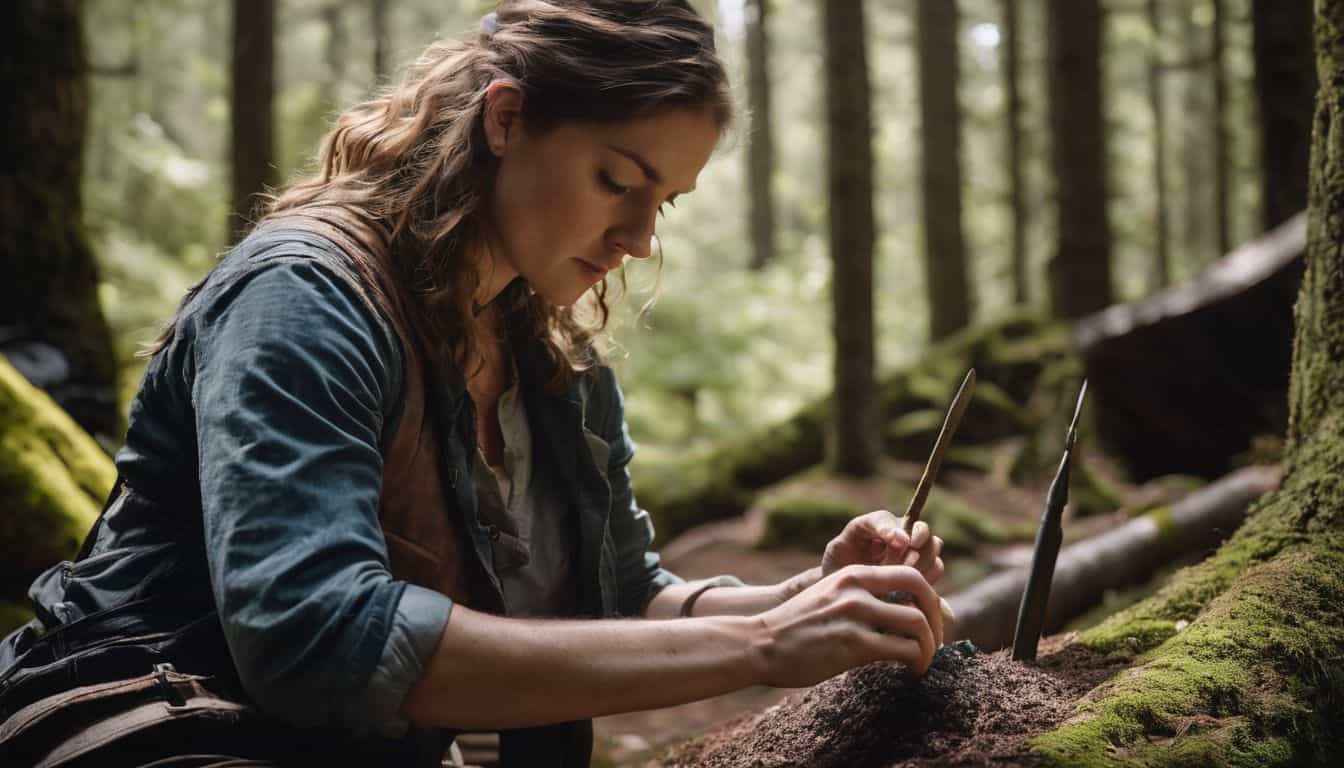Have you ever found yourself captivated by the notion of crafting and using primitive weapons? If you’re like me, this curiosity isn’t just passing fancy; it sticks around, whispering words of challenge.
After plunging into copious research and getting my hands dirty with practical experience, I’ve unveiled the unmistakable importance of arming oneself with these ancestral tools and the knowledge to use them for survival.
In this blog post, we’ll dig deep into the world of understanding, crafting and effectively wielding primitive weaponry as an integral aspect of wilderness survival skills. So strap in and get ready to embark on an exhilarating journey back to our human origins!
Key Takeaways
- Primitive weapons, such as spears and bows and arrows, are essential for self – defense and hunting in the wild.
- These ancient tools offer advantages over modern weapons, including the ability to make more ammunition and being quieter during use.
- Crafting primitive weapons requires selecting suitable materials like wood and stone, using basic tools, and following step-by-step processes for each weapon type.
The Importance of Primitive Weapons for Survival
Primitive weapons are essential for survival as they provide self-defense and hunting capabilities, offering advantages over modern weapons while also carrying historical significance.
Understanding the need for self-defense and hunting
In the wild, survival is tough. Knowing how to keep yourself safe and find food is crucial. This means you need skills for self-defense and hunting. Faced with danger, you want a weapon to protect yourself.
You can scare off or fight against threats using primitive weapons like bows and arrows or spears. Hunting also relies on these tools. By spear hunting or crossbow hunting, you secure food for yourself in the wild too! Not only that, but learning to use such traditional gear makes it real clear why these old-school methods have stuck around all this time! These are key reasons why understanding self-defense and hunting forms a big part of surviving out there on your own.
Advantages of using primitive weapons over modern ones
Primitive weapons have many benefits over new ones. First, they do not need gunpowder. This makes them easier to use and keep up when out in the wilds. They don’t break down or jam like modern guns might.
Another cool thing about old weapons is that you can make more arrows or spears as needed. If you know how, you can turn a stick into a spear right there in the forest! This means you will never run out of ammo.
Old ways are often quiet too. If I shoot an arrow at a deer, it won’t scare away all the animals close by like a gunshot would. So there’s a higher chance of catching dinner!
Using these simple tools needs less training than using modern firearms too. With some practice, anyone can learn to throw a spear or sling an arrow straight and far enough to hit its mark when it counts most: survival!
Historical significance of primitive weapons
Long ago, people used primitive weapons for a lot. They were not just tools but their key to life. They would use them to hunt for food. Not having one meant they could starve! It was also a way of safety from wild animals or other men who might wish them harm.
People have fought wars with these simple tools too, up until the early modern period. Now we don’t need them as much because of new technology, but some still find them useful in the wild outdoors or for old-style hunting methods.
Primitive weapon crafting is a nod at our past, reminding us how far we’ve come.
Basics of Crafting and Using Primitive Weapons

Additionally, learning basic tools and techniques for crafting weapons is crucial. This includes shaping materials, like carving a spearhead from a rock or fashioning arrows from sticks.
Once you have your weapon, practicing with it is necessary to develop accuracy and precision. Training in hunting techniques can help you become proficient at catching food for sustenance.
Self-defense skills are also vital for protection against threats in the wild. Mastering these basics will allow you to thrive while relying on primitive weapons in any survival situation.
Hunting techniques
Types of Primitive Weapons
Spears, javelins, bows and arrows, slingshots, atlatls, and knives and daggers are just a few examples of the fascinating types of primitive weapons that have been used throughout history.
Discover the unique characteristics and advantages of each weapon in this section. Keep reading to unlock the secrets of ancient weaponry!
Spears and javelins
Spears and javelins are essential primitive weapons for survival and bushcraft. They have been used throughout history for hunting and self-defense. Javelins, a specific type of spear, are designed to be thrown, offering increased range compared to regular spears.
To achieve even greater throwing power, an atlatl can be used as a spear-throwing device.
These weapons provide an efficient way to acquire food in survival situations. Spears can be used for thrusting, while javelins can be thrown at prey from a distance. By crafting and mastering the use of these primitive tools, you gain valuable skills that could save your life in the wilderness.
Bows and arrows
Bows and arrows have been used by humans for hunting and violence since ancient times. They are considered primitive weapons but can still be effective for survival in the wilderness.
While they may not have the power of guns, bows and arrows offer a useful alternative in certain situations. Throughout history, different types of bows and arrows have been developed, including compound bows, recurve bows, and crossbows.
These traditional weapons have stood the test of time and are valuable tools for hunting game or defending against predators.
Slingshots
Slingshots are ancient weapons that were used by hunters and warriors in the past. Native Americans, in particular, relied on slingshots for hunting and self-defense. What’s great about slingshots is that they don’t require a lot of resources or technology to make.
They are simple yet effective tools for survival. Slingshots work by hurling stones as projectiles, making them one of the most widely used primitive hunting weapons. With their ease of use and versatility, slingshots can be a valuable addition to your arsenal when venturing into the wilderness.
Atlatls
I’m excited to talk about atlatls, an ancient and fascinating type of primitive weapon. Atlatls were used by our ancestors for hunting, warfare, and even as a sport. These incredible tools predate the bow and arrow and were found on almost every continent.
They were especially revered in the Aztec culture. What made atlatls so special was their ability to improve throwing speed and distance, making them highly effective for hitting targets from afar.
With these enhanced throwing devices, hunters could take down prey more easily while keeping a safe distance. It’s truly amazing how such simple yet ingenious tools played such a crucial role in our history!

Knives and daggers
Knives and daggers are essential primitive weapons for survival. They were commonly used for hunting animals and protecting oneself from threats in the wilderness. Knives, in particular, played a significant role in human survival since they were one of the earliest tools used by humans.
Crafting these weapons is relatively straightforward, requiring simple hand tools and techniques. It’s important to note that the use and possession of knives and daggers, along with other primitive weapons, may be subject to regulations and laws depending on where you are.
When it comes to offensive purposes, using knives as blades tends to be more practical than using daggers. So if you’re looking to craft your own primitive weapon arsenal, don’t forget about the versatile capabilities of knives and daggers!
Crafting Primitive Weapons
Learn how to select the right materials and discover the step-by-step process for crafting your own primitive weapons. Ready to unleash your inner survivalist? Read more!
Selecting suitable materials
To craft effective primitive weapons, it’s important to select the right materials. Natural resources like wood and stone are commonly used for crafting traditional weapons. Wood can be chosen based on its strength and flexibility, such as hardwoods like oak or ash.
Stone should be durable and hard, like flint or obsidian. Additionally, special materials with unique properties can be utilized for crafting weapons or armor. These materials may possess innate strengths that make them particularly useful in specific situations or against certain threats.
By carefully selecting suitable materials, we can create effective tools for survival and self-defense in the wilderness using primitive skills passed down through generations.
Basic tools and techniques
Crafting primitive weapons requires a few basic tools and techniques. These tools include things like stone flakes for shaping, sharp rocks or bone shards for cutting, and sturdy sticks to serve as handles.
Techniques involve using these tools effectively to shape materials into functional weapons. For example, you might use a hammerstone to strike the edge of a rock and create a sharp edge.
You could also use pressure flaking to carefully chip away at stones to make arrowheads or spear tips. By mastering these basic tools and techniques, you can create effective primitive weapons for survival in the wilderness.
Step-by-step process for crafting each type of weapon
Crafting primitive weapons is an art that requires patience and skill. As a survival enthusiast, here are the step-by-step processes for crafting each type of weapon:
- Spears and Javelins:
- Find a suitable straight stick or pole.
- Sharpen one end into a point using a knife or sharp rock.
- Attach a stone or bone tip securely to increase effectiveness.
- Bows and Arrows:
- Select a flexible branch for the bow.
- Cut notches at both ends for the string.
- Use animal sinew or strong plant fibers as the string.
- Craft arrows from straight sticks with sharpened tips.
- Slingshots:
- Find a Y – shaped branch with an elastic limb.
- Attach elastic bands or cords to form the sling part.
- Use stones or small projectiles as ammunition.
- Atlatls:
- Carve a long, thin wooden handle for throwing spears.
- Create a hook – like projection at one end to hold the spear.
- Attach feathers to stabilize the spear during flight.
- Knives and Daggers:
- Choose a sturdy piece of bone, antler, or stone for the blade.
- Shape the material into a sharp edge using grinding tools like rocks or sandstone.
- Attach the blade securely to a handle made from wood, bone, or leather strips.
Mastering the Use of Primitive Weapons
To become proficient in using primitive weapons, it is crucial to devote time to training and practice, honing your accuracy and precision for both hunting and self-defense purposes.
Training and practice
To become proficient in using primitive weapons, training and practice are crucial. By dedicating time and effort to mastering these skills, you can develop the necessary accuracy and precision needed for hunting and self-defense.
The techniques used by our ancient ancestors in prehistoric combat serve as valuable lessons to learn from. Additionally, it’s important to familiarize yourself with the basic weapon training required for wielding traditional arms effectively.
Through indigenous warfare methods and ancient battle tactics, you can hone your abilities in utilizing archaic weaponry. Remember that skill development is an ongoing process, requiring dedication and perseverance.
Developing accuracy and precision
When it comes to using primitive weapons, developing accuracy and precision is crucial. It takes practice and skill to become proficient in hitting targets consistently. Whether you’re hunting for food or defending yourself, being able to hit your mark accurately is essential.
By mastering the use of primitive weapons, such as spears, bows and arrows, and slingshots, you can improve your aim through training and technique. This includes learning how to hold the weapon properly, aiming with precision, and adjusting for distance and wind conditions.
With time and effort, you can develop the accuracy and precision needed to thrive in the wilderness with these traditional tools.
Techniques for hunting and self-defense
When it comes to hunting and self-defense, there are a few important techniques to keep in mind. Here are some ways to improve your skills with primitive weapons:
- Aim for accuracy: Practice regularly to improve your aim and precision. Start by aiming at stationary targets and gradually work your way up to moving targets.
- Understand stealth: Learn how to move silently and blend into your surroundings. This will help you get closer to your target without alerting them.
- Develop patience: Hunting requires patience, so be prepared to wait for the right moment. Take your time and wait for the perfect opportunity to make your move.
- Learn tracking skills: Being able to track animals or potential threats is crucial for successful hunting and self-defense. Study animal tracks, signs of movement, and other indicators that can lead you to your target.
- Use camouflage effectively: Blend in with your surroundings by wearing appropriate camouflage clothing or using natural materials as cover when stalking prey or hiding from potential threats.
- Practice stealthy approaches: Learn how to approach an animal or potential threat quietly and unnoticed. Move slowly, avoid sudden movements, and stay low if necessary.
- Master different shooting positions: Be comfortable shooting from various positions like kneeling, sitting, or lying down. This will allow you to adapt quickly in different hunting or self-defense situations.
- Consider trap-setting techniques: Alongside traditional hunting techniques, learn how to set traps using available resources like ropes, sticks, or natural baits.
Gathering and Preparing Resources for Crafting
To craft primitive weapons, it is crucial to gather and prepare suitable materials for crafting.
Identifying and collecting suitable materials
To craft effective primitive weapons, it’s crucial to identify and collect the right materials. Look for resources like strong branches, sturdy rocks, and sharp stones that can be shaped into weapon components.
Additionally, consider gathering natural fibers or animal sinew for bindings and strings. Being resourceful in your surroundings is key to finding suitable materials for crafting primitive weapons.
By using raw resources like ores, trees, fish, and crops found in the wilderness, you can acquire the necessary materials for crafting tools of survival effectively. It’s all about carefully selecting and amassing the right elements needed to create a reliable weapon that can help you thrive in any situation.
Processing and shaping materials
Crafting primitive weapons requires careful processing and shaping of materials. In the Stone Age, our ancestors used stone as their main resource for toolmaking. They would carefully select suitable stones and then use techniques like flintknapping to shape them into useful implements.
This craftsmanship was an important part of their cultural heritage and played a significant role in their survival. Understanding the characteristics of neolithic tools is crucial for gaining insight into this time period and honing our own skills in crafting primitive weapons.
Strategies for Thriving with Primitive Weapons
To thrive with primitive weapons, it is crucial to develop effective hunting strategies, build sturdy shelters for protection, and be prepared to defend against potential threats.
Hunting for food
As a survival enthusiast, one of the essential skills to thrive in the wilderness is hunting for food. Just like ancient hunter-gatherers, you can rely on primitive weapons to secure your meals.
By mastering the art of hunting with spears, bows and arrows, slingshots, or atlatls, you’ll be able to track and hunt animals effectively. Combine your indigenous knowledge of animal behaviors with tracking techniques to increase your chances of success.
Additionally, don’t forget about edible plant identification as it provides an alternative food source. With sustainable hunting practices and basic cooking methods using natural resources around you, you can truly embrace the nomadic lifestyle and thrive in the wild.
Building shelter and protection
Building a shelter is incredibly important when it comes to surviving in the wilderness. You need a safe and secure place to rest, protect yourself from harsh weather conditions, and stay hidden from potential dangers.
The Wilderness Survival Handbook provides valuable tips on constructing sturdy shelters using natural materials found in your surroundings. It also offers guidance on starting fires using friction methods, which are effective and efficient.
By learning these skills, you can ensure that you have a reliable shelter and adequate protection while thriving in the wilderness. With the right knowledge and resources, building shelter becomes an essential part of your survival strategy as you navigate through nature’s challenges.
Defending against threats
Defending against threats is a crucial aspect of thriving in survival situations. When it comes to self-defense, primitive weapons are often the best option. They provide a reliable means of protection without relying on modern technology.
Additionally, they can be crafted using basic hand tools and materials found in nature. Whether it’s using a spear for hunting or a sling for personal protection, mastering the use of primitive weapons can greatly enhance your ability to defend yourself in the wilderness.
With the potential threat posed by artificial intelligence security breaches and an ever-changing threat landscape, having these skills is more important than ever. Remember that practicing regularly and developing accuracy are key to effectively using these weapons for defense purposes.
Important Considerations for Using Primitive Weapons
Ensure you follow safety precautions, practice ethical hunting practices, and stay informed about legal regulations and restrictions.
Safety precautions
Safety is of utmost importance when it comes to crafting and using primitive weapons. It’s crucial to follow specific safety guidelines, especially for muzzleloaders, which require annual review of safety use rules.
Beyond general firearms safety, hunting with primitive weapons also demands extra caution. These weapons have the potential to harm both humans and animals, so it is our responsibility to ensure everyone’s safety.
When engaging in crafting activities involving dangerous tools or toxic materials, young children should always be supervised. It’s important to refrain from eating, drinking, or smoking while using art and crafts materials to avoid any accidents or ingestion of toxins.
Ethical hunting practices
When using primitive weapons for crafting and hunting, it is important to follow ethical hunting practices. This means obeying all applicable laws and regulations regarding hunting.
It also means respecting the customs of the locale where you are hunting. Additionally, exercising a personal code of behavior that reflects ethical hunting practices is crucial. By being mindful and considerate in our actions, we can ensure sustainable hunting practices and contribute to conservation efforts.
Let’s embrace the art of primitive weapon crafting while keeping these important considerations in mind.
Legal regulations and restrictions
When it comes to using primitive weapons for hunting, there are important legal regulations and restrictions that we need to keep in mind. For example, in Mississippi, archery equipment and primitive firearms are allowed during the Primitive Weapons season.
However, specific seasons and a list of legal weapons apply. In Texas, there are regulations in place for hunting with primitive weapons which should be followed closely. It’s also crucial to review safety rules annually, especially those related to muzzleloaders.
Additionally, increasing the availability of primitive weapons tags can provide more opportunities for hunting. Let’s make sure we stay informed about these regulations to ensure we hunt responsibly and within the law.
Challenges and Limitations of Using Primitive Weapons
Using primitive weapons comes with its own set of challenges and limitations, such as the range and accuracy limitations that may require hunters to get closer to their prey, physical strength and stamina requirements for wielding these weapons effectively, and the need for adaptability in different environments and situations.
Range and accuracy limitations
Primitive weapons, while effective for survival and hunting, do have limitations when it comes to range and accuracy. Unlike modern firearms that can shoot long distances with great precision, primitive weapons have a shorter range and are less accurate.
This is because they rely on the physical strength and skill of the user rather than advanced technology. The specific type of weapon and the proficiency of the person using it also play a role in determining its range and accuracy.
However, these limitations can be overcome through practice, knowledge, and experience in crafting and using primitive weapons. While they may not offer the same level of range and accuracy as modern firearms, primitive weapons can still be highly effective tools for both self-defense and hunting in survival situations.
Physical strength and stamina requirements
Crafting and using primitive weapons can be physically demanding. It requires strength and stamina to effectively wield these weapons for hunting or self-defense. You need strong muscles and endurance to throw a spear or draw back a bowstring.
Crafting primitive weapons also takes time, as you’ll be using simple hand tools to shape materials like wood and stone. Being fit and having the energy to endure long periods of physical activity will greatly enhance your ability to thrive with primitive weapons in the wilderness.
Embracing regular exercise, practicing weapon handling techniques, and building up your muscle strength can help you meet the physical demands of using these ancient tools effectively in survival situations.
Adaptability to different environments and situations
Primitive weapons are incredibly versatile and can be adapted to a wide range of environments and situations. Whether you find yourself in dense forests, open plains, or rocky terrains, primitive weapons can help you survive and thrive.
With their simplicity and minimalistic design, these ancient tools can be crafted using basic materials found in nature. From hunting for food to defending against threats, primitive weapons have been used by indigenous tribes and nomadic communities for centuries.
Their adaptability makes them an essential part of survival skills, allowing you to navigate varied landscapes and diverse scenarios with ease. So embrace the art of primitive weapon crafting and unlock your potential to thrive in the wilderness!
Conclusion: Embracing the Art of Primitive Weapon Crafting and Thriving in the Wilderness
Embrace the art of crafting and using primitive weapons to thrive in the wilderness. With these weapons, you can defend yourself and hunt for food. Learn about different types of primitive weapons, how to craft them with basic tools and techniques, and master their use through training and practice.
By gathering suitable materials and developing your skills, you can build shelter, protect yourself from threats, and thrive in challenging environments. So why wait? Start embracing the art of primitive weapon crafting today!
FAQs on Crafting and Using Primitive Weapons
1. What are primitive weapons?
Primitive weapons are tools made from basic materials found in nature, such as rocks, sticks, and bones. They were used by our ancestors for hunting and self-defense.
2. How can I craft a primitive weapon?
To craft a primitive weapon, you can start by finding or shaping a suitable material like wood or stone into the desired shape. You may also need to use cords or bindings to secure different parts together.
3. What are some examples of primitive weapons?
Examples of primitive weapons include spears, bows and arrows, slingshots, and clubs. These simple tools were effective for hunting small game or defending against predators.
4. Can I legally use primitive weapons for self-defense today?
The legality of using primitive weapons for self-defense varies depending on your location and local laws. It is advisable to research and understand the specific regulations in your area before considering their use for defense purposes.
5. Are there any safety precautions when using primitive weapons?
Yes, when using primitive weapons, it is important to prioritize safety. Always practice proper handling techniques to prevent accidents or injuries to yourself or others around you.





Leave a Reply